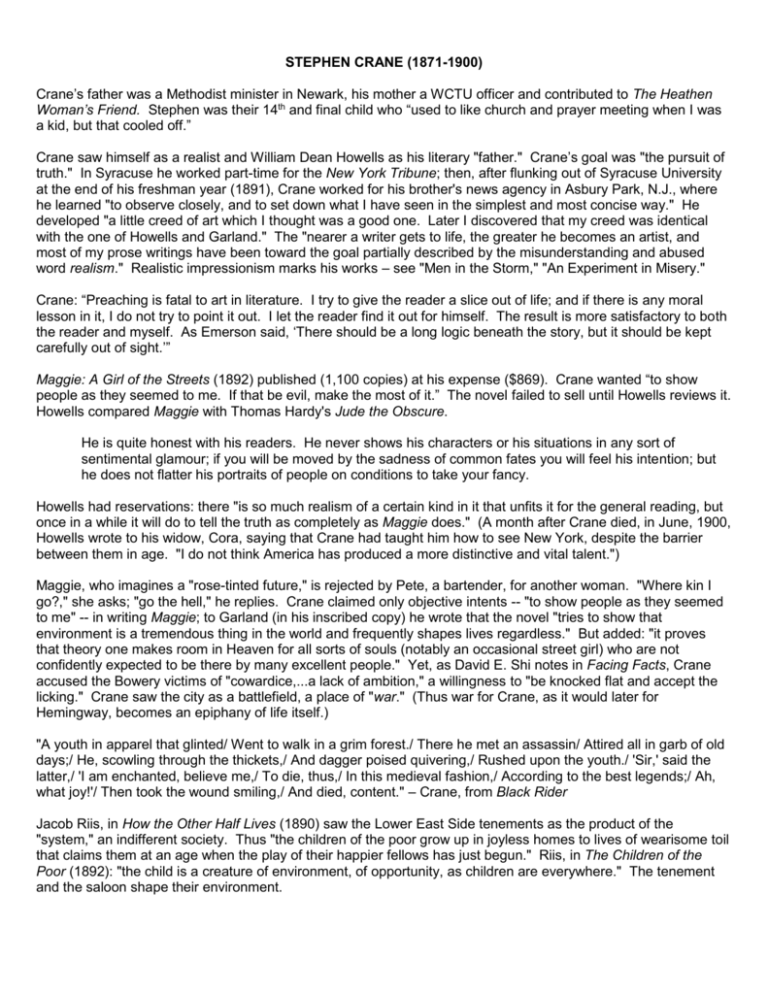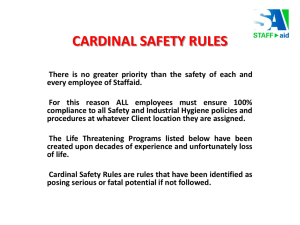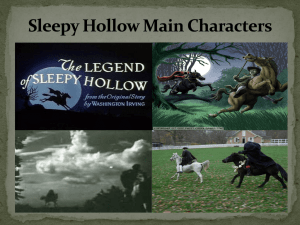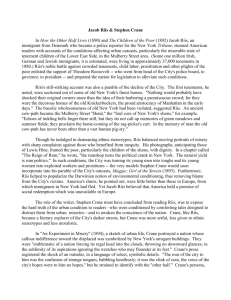STEPHEN CRANE (1871
advertisement

STEPHEN CRANE (1871-1900) Crane’s father was a Methodist minister in Newark, his mother a WCTU officer and contributed to The Heathen Woman’s Friend. Stephen was their 14th and final child who “used to like church and prayer meeting when I was a kid, but that cooled off.” Crane saw himself as a realist and William Dean Howells as his literary "father." Crane’s goal was "the pursuit of truth." In Syracuse he worked part-time for the New York Tribune; then, after flunking out of Syracuse University at the end of his freshman year (1891), Crane worked for his brother's news agency in Asbury Park, N.J., where he learned "to observe closely, and to set down what I have seen in the simplest and most concise way." He developed "a little creed of art which I thought was a good one. Later I discovered that my creed was identical with the one of Howells and Garland." The "nearer a writer gets to life, the greater he becomes an artist, and most of my prose writings have been toward the goal partially described by the misunderstanding and abused word realism." Realistic impressionism marks his works – see "Men in the Storm," "An Experiment in Misery." Crane: “Preaching is fatal to art in literature. I try to give the reader a slice out of life; and if there is any moral lesson in it, I do not try to point it out. I let the reader find it out for himself. The result is more satisfactory to both the reader and myself. As Emerson said, ‘There should be a long logic beneath the story, but it should be kept carefully out of sight.’” Maggie: A Girl of the Streets (1892) published (1,100 copies) at his expense ($869). Crane wanted “to show people as they seemed to me. If that be evil, make the most of it.” The novel failed to sell until Howells reviews it. Howells compared Maggie with Thomas Hardy's Jude the Obscure. He is quite honest with his readers. He never shows his characters or his situations in any sort of sentimental glamour; if you will be moved by the sadness of common fates you will feel his intention; but he does not flatter his portraits of people on conditions to take your fancy. Howells had reservations: there "is so much realism of a certain kind in it that unfits it for the general reading, but once in a while it will do to tell the truth as completely as Maggie does." (A month after Crane died, in June, 1900, Howells wrote to his widow, Cora, saying that Crane had taught him how to see New York, despite the barrier between them in age. "I do not think America has produced a more distinctive and vital talent.") Maggie, who imagines a "rose-tinted future," is rejected by Pete, a bartender, for another woman. "Where kin I go?," she asks; "go the hell," he replies. Crane claimed only objective intents -- "to show people as they seemed to me" -- in writing Maggie; to Garland (in his inscribed copy) he wrote that the novel "tries to show that environment is a tremendous thing in the world and frequently shapes lives regardless." But added: "it proves that theory one makes room in Heaven for all sorts of souls (notably an occasional street girl) who are not confidently expected to be there by many excellent people." Yet, as David E. Shi notes in Facing Facts, Crane accused the Bowery victims of "cowardice,...a lack of ambition," a willingness to "be knocked flat and accept the licking." Crane saw the city as a battlefield, a place of "war." (Thus war for Crane, as it would later for Hemingway, becomes an epiphany of life itself.) "A youth in apparel that glinted/ Went to walk in a grim forest./ There he met an assassin/ Attired all in garb of old days;/ He, scowling through the thickets,/ And dagger poised quivering,/ Rushed upon the youth./ 'Sir,' said the latter,/ 'I am enchanted, believe me,/ To die, thus,/ In this medieval fashion,/ According to the best legends;/ Ah, what joy!'/ Then took the wound smiling,/ And died, content." – Crane, from Black Rider Jacob Riis, in How the Other Half Lives (1890) saw the Lower East Side tenements as the product of the "system," an indifferent society. Thus "the children of the poor grow up in joyless homes to lives of wearisome toil that claims them at an age when the play of their happier fellows has just begun." Riis, in The Children of the Poor (1892): "the child is a creature of environment, of opportunity, as children are everywhere." The tenement and the saloon shape their environment.









